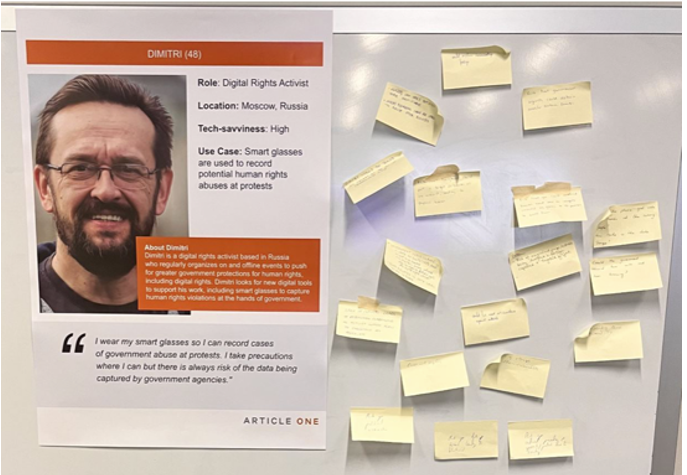CHALLENGE: ARTICLE ONE LED PARTICIPANTS AT THE INTEL SYMPOSIUM IN DUBLIN THROUGH A DEMO RESPONSIBLE FORESIGHT WORKSHOP DESIGNED TO HELP PARTICIPANTS EXPERIENCE RESPONSIBLE PRODUCT DESIGN IN ACTION.
I really want to bring this workshop back to my company. Having the space to deeply discuss risks and bring everyone’s experiences and expertise together was really powerful. This workshop really shed light on just how far-reaching these risks can be!
— Workshop participant
APPROACH
The two-hour in-person event followed Article One’s Responsible Foresight Workshop methodology, which includes a three-part approach that is often conducted over two workshops.

Part One was designed to introduce the product and personas. The product in this case was a hypothetical set of smart glasses with built in cameras and voice assistant integration. Typically, the product is selected by our client and represents a new technology or feature where a deeper dive on responsibility challenges is warranted.
Based on the project, Article One developed four unique personas. These personas were designed to help participants step into the shoes of vulnerable groups – whether users of smart glasses or others who might be impacted by the product. The personas spanned age, geographic location, technical ability, and identity. Cynthia, for example, is a transgender beauty influencer from Chicago who uses smart glasses to record content for her social media channel.

Part Two was designed to surface risks related to the product’s use. Participants spent time ideating on risks related to each persona, including both direct risks to them or to broader society via their use of the smart glasses. Using sticky notes, participants wrote down various risks – from privacy risks to safety risks to free expression risks and so on – and put the sticky notes on the correspond persona’s posterboard.

Once risks were surfaced, Article One facilitators then led participants in a risk prioritization exercise to identify the most salient risks across all the personas based on the degree of harm potentially experienced, the number of people potentially impacted, and the likelihood of the harm being experienced.
In Part Three, participants brainstormed potential mitigations for the most salient risks and categorized them by mitigation type, including product, design, legal and policy, user and bystander education, stakeholder engagement, and marketing strategies.
FINDINGS
Participants surfaced 68 unique risks across six key themes: privacy, accessibility and non-discrimination, physical safety, societal impact, harassment, and minor safety. After distilling the most salient risks from that list of 68 (e.g., bystander privacy, government and employer surveillance, and stifling of free expression), we discussed recommendations for mitigating risks ranging from product changes and features to user education and grievance mechanisms to policy development.
IMPACT
Participants came away from the Demo Workshop with an understanding of how to proactively identify potential responsibility risks associated with product design and deployment. They understood the value of personas and how they can help guide brainstorming and build empathy for eventual product users and other impacted parties. Participants were also able to understand a new way of prioritizing risks during the product development lifecycle and build in mitigations to help ensure a responsible product launch.
Would you like to learn more about Article One’s Responsible Foresight Workshops? We’d love to chat! Learn more here and reach out at hello@articleoneadvisors.com.
Top photo attribution: Android Authorit.